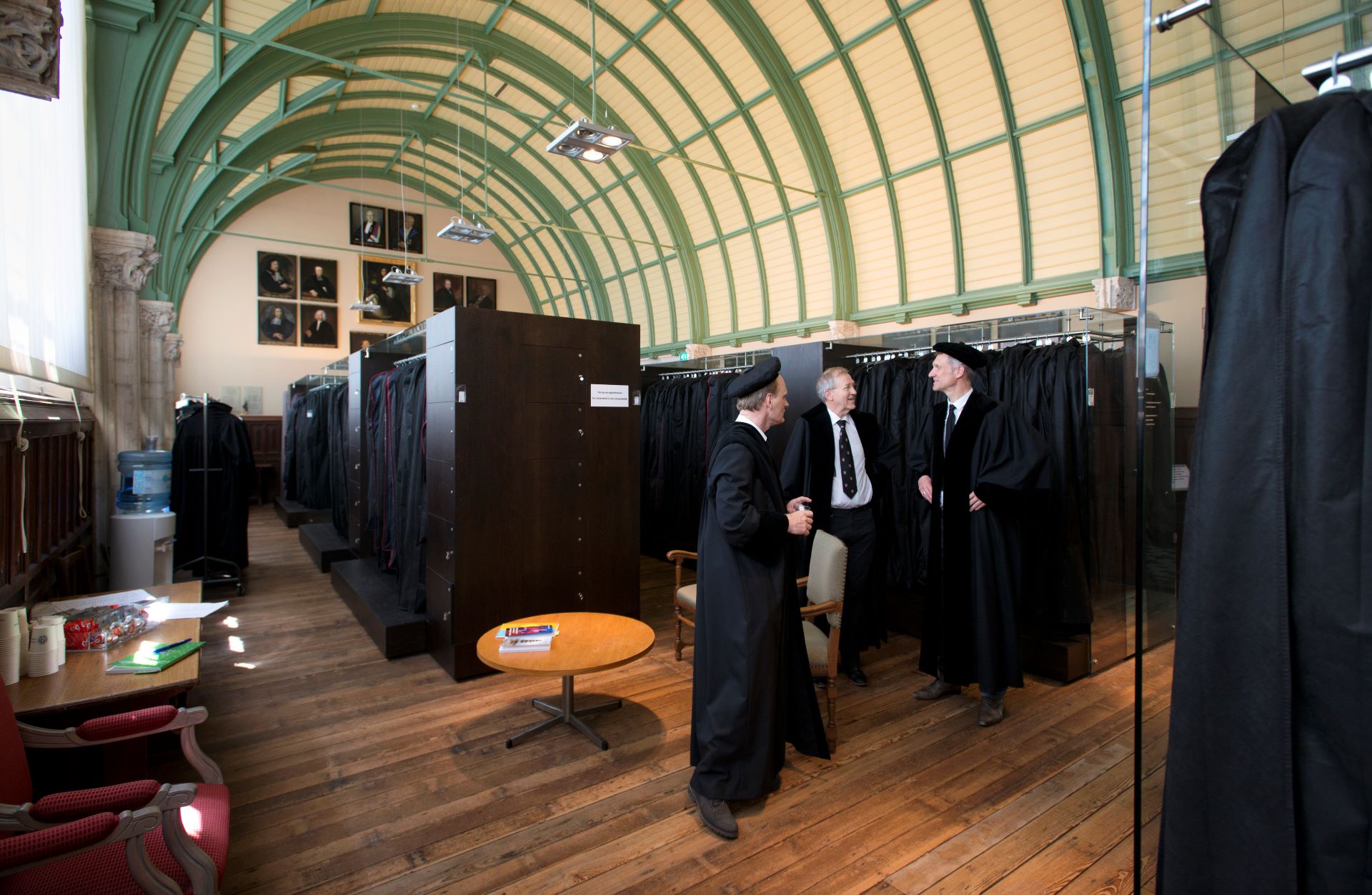
Not only full professors: the entire examining committee can now wear academic dress
The varied mix of dress styles and many shades of black will no longer be seen at PhD ceremonies: permission was recently given for all members of the examining committee and co-supervisors to wear academic dress, even if they’re not full professors. This relaxation of the rule emphasises that all the members are equal. How historic is this change?
Until recently, computer scientist Jan van Rijn ‘just wore a smart suit’ when he was acting as a co-supervisor or member of the examining committee at a PhD defence. As we know, the right to wear academic dress was reserved for full professors. But on 17 January 2024 both he, as the co-supervisor, and the members of the examining committee took part in a notable ‘first’. The occasion was Mike Huisman’s PhD defence. Shortly before 10 o’clock in the morning, they entered the Great Auditorium, all wearing academic dress for the first time. They could do this because Leiden University’s academic dress protocol was extended in January this year and the same is true for the University of Amsterdam, for example.

Preparing the way
This change was partly the result of arguments put forward by Leiden University professor Ineke Sluiter and The Young Academy of KNAW. Rector Magnificus Hester Bijl also supported this relaxation of the rule. One of the driving factors was the 2023 Everyone Professor proposal, in which The Young Academy advocated giving assistant professors (university lecturers; UDs) and associate professors (senior university lecturers; UHDs) the right to act as first supervisor, use the title ‘professor’ and wear academic dress at PhD defences.
For some time, Ineke Sluiter and Athena’s Angels – four female professors fighting for equal opportunities in academia – have wanted to do something about ‘non-functional hierarchy’ within the university. As Sluiter points out, it can undermine social safety and workplace enjoyment.
‘The right to wear academic dress was low-hanging fruit’
Academic dress is work clothing
‘It’s difficult to resolve all the issues around ius promovendi (the right to confer the title of ‘doctor’ on PhD candidates, ed.) at once,’ she says. ‘But the right to wear academic dress was low-hanging fruit.’ Sluiter briefly considered two scenarios: either everyone wears academic dress or she herself, as a professor, decides not to wear it. She chose the first option. ‘It’s not because I myself care so much about academic dress, but rather because the whole “pomp and circumstance” of a Leiden University PhD defence is so enjoyable for the PhD candidate, family and friends, and contributes to the ceremonial nature of the occasion.’
-

The gown room in the Academy Building. Photo Marc de Haan. -

There are also gowns in the gown room that people who do not have one can borrow. Photo Marc de Haan
Expertise of non-professors
Sluiter therefore presented her case at a meeting last year, which included deans and academic directors. ‘My arguments were that all members of the examining committee have the same role; that in fact it’s often the non-professors who are really in the committee for their expertise alone; and that it means the audience will no longer get the wrong impression that a question asked by someone in academic dress has more weight than the ones asked by other members.’ And actually this isn’t such a new idea, she adds. ‘Every PhD defence is chaired by a prorector, who wears the chain-of-office of the Rector Magnificus. That doesn’t make us think that the prorector is going to leave the Academy Building and start claiming the rights of the Rector Magnificus in all other situations. Academic dress during the PhD defence is simply work clothing.’
‘It’s great that the recognition is reflected in what we wear’
Recognition for doing most of the supervision
Sluiter’s proposal was widely supported, and Rector Magnificus Bijl then spoke with the Board of Deans, who gave their consent. Bijl is happy about the change: ‘Academic dress for all the committee members expresses that they all have the same role as an expert. For the co-supervisors too, it’s a recognition of their great efforts in the PhD track; they’re sometimes responsible for doing most of the candidate’s supervision.’ The fact that until recently only full professors were permitted to wear academic dress is a less long-standing tradition than people often think, remarks Bijl. It was only in the 20th century that it became an exclusive right for full professors. University historian Pieter Slaman explains below.
Academic dress only became exclusive later
Extending the right to wear academic dress actually revives a long tradition, says Slaman. ‘In the Middle Ages, the gown was ordinary everyday attire for the entire academic community, including students. But in the 16th, 17th and 18th centuries, students only wore it during their PhD defence. All the teaching staff, however, from full professors down to junior lecturers, continued to wear a gown. This only changed in the 20th century: the rapidly growing number of staff members resulted in more academic ranks, the highest of which were afraid of losing their status. This is why they reserved the right to wear academic dress for themselves. Therefore making the decision in 2024 to allow examining committee members to wear academic dress simply refers back to the time when the gown was an adornment for scholars in general, which emphasises the equality among them all.’
A part of academic tradition
Back now to Jan van Rijn’s ‘first’ in terms of academic dress. ‘It was a very special moment,’ he recalls. ‘I really felt I was a part of Leiden University’s academic tradition. In the past, I never really minded that I wasn’t allowed to wear academic dress. But wearing it in Leiden for the first time made me realise that it’s actually very logical to extend this right. We’re all experts and it’s great that this recognition is now also reflected in what we wear.’
Text: Linda van Putten
